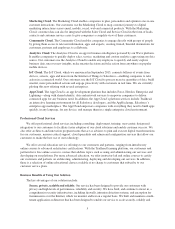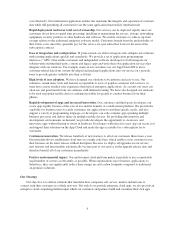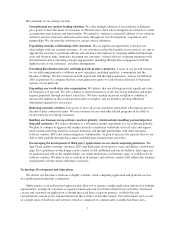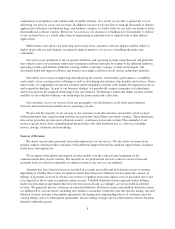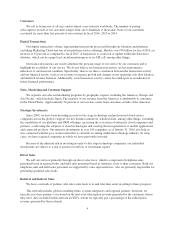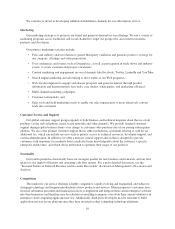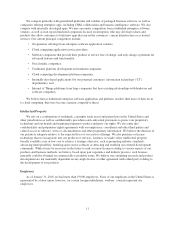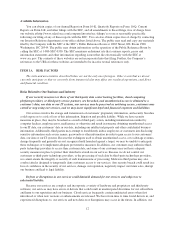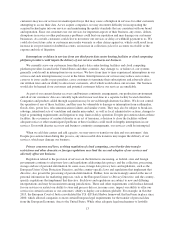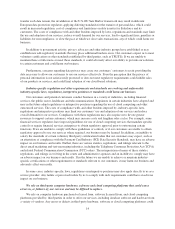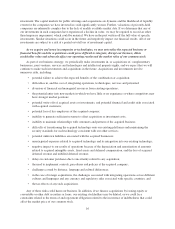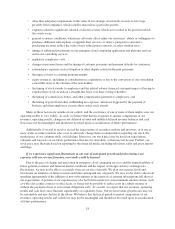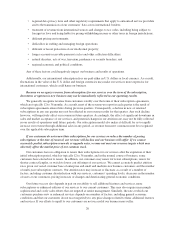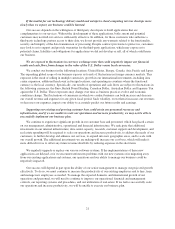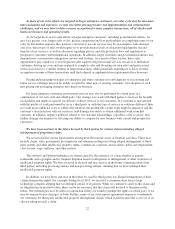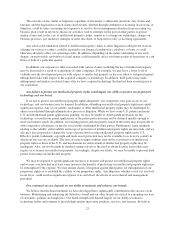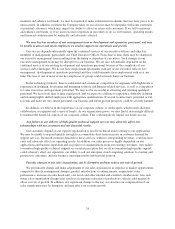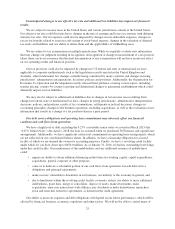Salesforce.com 2016 Annual Report Download - page 22
Download and view the complete annual report
Please find page 22 of the 2016 Salesforce.com annual report below. You can navigate through the pages in the report by either clicking on the pages listed below, or by using the keyword search tool below to find specific information within the annual report.result in errors in, or a failure of, our services, which could harm our business. These hardware, software and
cloud computing platforms may not continue to be available at reasonable prices, on commercially reasonable
terms or at all. Any loss of the right to use any of these hardware, software or cloud computing platforms could
significantly increase our expenses and otherwise result in delays in the provisioning of our services until
equivalent technology is either developed by us, or, if available, is identified, obtained through purchase or
license and integrated into our services.
The market in which we participate is intensely competitive, and if we do not compete effectively, our
operating results could be harmed.
The market for enterprise applications and platform services is highly competitive, rapidly evolving and
fragmented, and subject to changing technology, shifting customer needs and frequent introductions of new
products and services. We compete primarily with generalized platforms and vendors of packaged business
software, as well as companies offering enterprise apps, including CRM, collaboration and business intelligence
software. We also compete with internally developed apps and face competition from enterprise software
vendors and online service providers who may develop toolsets and products that allow customers to build new
applications that run on the customers’ current infrastructure or as hosted services. Our current competitors
include:
• on premise offerings from enterprise software application vendors;
• cloud computing application service providers;
• software companies that provide their product or service free of charge, and only charge a premium for
advanced features and functionality;
• social media companies;
• traditional platform development environment companies;
• cloud computing development platform companies;
• internally developed applications (by our potential customers’ IT departments); and
• Internet of Things platforms from large companies that have existing relationships with hardware and
software companies.
Many of our current and potential competitors enjoy substantial competitive advantages, such as greater
name recognition, longer operating histories and larger marketing budgets, as well as substantially greater
financial, technical and other resources. In addition, many of our current and potential competitors have
established marketing relationships and access to larger customer bases, and have major distribution agreements
with consultants, system integrators and resellers. As a result, our competitors may be able to respond more
quickly and effectively than we can to new or changing opportunities, technologies, standards or customer
requirements. Furthermore, because of these advantages, even if our services are more effective than the products
and services that our competitors offer, potential customers might select competitive products and services in lieu
of purchasing our services. For all of these reasons, we may not be able to compete successfully against our
current and future competitors.
We are subject to risks associated with our strategic investments. Other-than-temporary impairments in
the value of our investments could negatively impact our financial results.
We invest in early-to-late stage companies for strategic reasons and to support key business initiatives, and
may not realize a return on our strategic investments. Many such companies generate net losses and the market
for their products, services or technologies may be slow to develop, and, therefore, are dependent on the
availability of later rounds of financing from banks or investors on favorable terms to continue their operations.
The financial success of our investment in any company is typically dependent on a liquidity event, such as a
public offering, acquisition or other favorable market event reflecting appreciation to the cost of our initial
15


